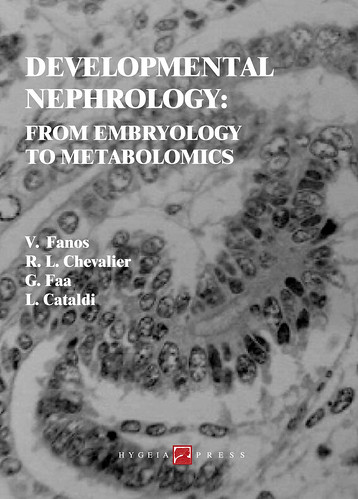Developmental Nephrology: From Embryology to Metabolomics
buy | description | main topics | contents | look inside | flyer | ebook
Order this book on IBS!
IBS provides international delivery, you can read the delivery rates here: IBS delivery rates.
This book is also available in the bookshops listed on the page “HOW TO ORDER – COME ORDINARE“.
For more information about this book, please send us an email at hygeiapress@hygeiapress.com.
Description

“Developmental Nephrology: From Embryology to Metabolomics” edited by Vassilios Fanos, Robert L. Chevalier, Gavino Faa, Luigi Cataldi
ISBN 9788890438929, book series: Systems Medicine, 272 pages, Hardcover, € 80, 1st edition: October 2011
Authors: Rino Agostiniani, Karel Allegaert, Fani Anatolitou, Roberto Antonucci, Jacob V. Aranda, Alessandra Atzei, Luigi Atzori, Luigi Barberini, Kay D. Beharry, Martina Bertin, Luigi Cataldi, Robert L. Chevalier, Nataliya Chorny, Erich Cosmi, Laura Cuzzolin, Ernesto D’Aloja, Mario De Curtis, Angelica Dessì, Gavino Faa, Daniela Fanni, Vassilios Fanos, Gabriele Finco, Helen Georgaki-Angelaki, Clara Gerosa, Hercília Guimarães, Nicoletta Iacovidou, Maria Antonietta Marcialis, Viviana Marinelli, Silvio Maringhini, Alice Melis, Guido Monga, Michele Mussap, Sonia Nemolato, Antonio Noto, Giovanni Ottonello, Maria Dolores Pilloni, Bernadette Pinna, Maria Cristina Pintus, Melania Puddu, Elisabetta Puxeddu, Jacques Rigo, Luigi Ruggeri, Kosmas Sarafidis, Morris Shoeneman, Teresa Tomé, Daniele Trevisanuto, Maria Elisabetta Trudu, Gloria B. Valencia, John N. van den Anker, Silvia Visentin, Murat Yurdakök, Marco Zaffanello, Vincenzo Zanardo
The traditional approach to kidney disorders is changing. In the field of diagnostics much innovative research is ongoing: from the “old” embryology, revisited and re-interpreted with new eyes in the light of immunohistochemistry, up to metabolomics the latest “daughter” of genomics, the most promising and remarkable of the “omics” disciplines.
Between these two extremes we find a universe of novelties, ranging from the most recent urinary biomarkers to the questions of nutrition and growth, as well as those of ethics, which the new populations of extremely low birth weight (ELBW) neonates present to neonatologists and nephrologists.
The studies on perinatal programming expand the temporal horizon of precocious reduction in the number of nephrons, both congenital and/or acquired, thus dilating and multiplying the immediate and long-term negative effects. Neonatal asphyxia, obstructive uropathies, nephrotoxic drugs administered to the mother and/or to the neonate, malnutrition, underfeeding, or overfeeding make it necessary to apply all possible preventive measures to ensure the well-being of the kidney. Because of the kidney’s holistic dimension, the methodical and rigorous study of neonatal nephrology has advanced all aspects of health through the life cycle.
This volume is an update state of the art of the latest discoveries in neonatal and pediatric nephrology. These advances will have an even greater impact when the same children reach adulthood, and the ultimate consequences of perinatal care are unmasked.
Main topics
Aminoglycosides – Antifungals – Aquaporins – Asphyxia – Ethical issues – Intrauterine growth restriction – Italian Neonatal Nephrology Study Group – Kidney embryogenesis – Metabolomics – Nephrotoxicity – Non-steroidal anti-inflammatory drugs – Nutrition – Obstructive uropathy – Pediatric nephrogenic syndrome of inappropriate antidiuresis – Perinatal programming – Pyelonephritis – Sepsis – Ultrasounds – Urinary biomarkers
Contents
1. Kidney embryogenesis: how to look at old things with new eyes
Gavino Faa, Clara Gerosa, Daniela Fanni, Sonia Nemolato, Guido Monga, Vassilios Fanos
A fascinating traffic of cells and tissues • Morphological sequence of events in human kidney development • Molecular regulation of nephrogenesis • Embryology and carcinogenesis: how to better understand kidney tumors by studying tissue expression of transcription factors • Kidney development: can we trace adult kidney behavior to the nine months before birth? • Conclusions and future challenges • References
2. Obstructive uropathy: the state of the art
Robert L. Chevalier
Pathogenesis of obstructive uropathy: animal models • Cellular and molecular mechanisms of obstructive renal injury • Renal growth and glomerular injury • Renal tubular injury • Renal interstitial injury • The role of angiotensin • Evaluation and management of upper tract obstruction • Evaluation and management of lower tract obstruction • Long-term follow-up and the future • References
3. Perinatal programming: long-term consequences for the kidney
Melania Puddu, Luigi Cataldi, Gavino Faa, Murat Yurdakök, Silvio Maringhini, Vassilios Fanos
Is the neonate the father of the adult? • Developmental programming of the kidney and epigenetics • Low neonatal weight and kidney diseases: a dangerous couple • From epidemiology to the clinic and experimentation… • …to pathological anatomy • Renal programming in the VLBW and ELBW: old and new • The influence of pre- and postnatal nutrition • The final number of nephrons as the key factor in the health of the kidney and the organism • Drugs and modulation of nephrogenesis • Future directions • References
4. Aquaporins: implications for the newborn infants
Jacob V. Aranda, Elisabetta Puxeddu, Nataliya Chorny, Morris Shoeneman, Gloria B. Valencia, Kay D. Beharry
Aquaporins • Clinical relevance for the newborn infant •Aquaporins in the eyes • Renal ontogeny of aquaporins • References
5. Pediatric nephrogenic syndrome of inappropriate antidiuresis
Maria Antonietta Marcialis, Angelica Dessì, Maria Cristina Pintus, Bernadette Pinna, Luigi Ruggeri, Vassilios Fanos
Mechanism of action of AVP • Frequency of NSIAD • Symptomatology • Therapy • Future directions • Take-home messages • References
6. Nutrition and kidney in preterm infant
Mario De Curtis, Jacques Rigo
Intrauterine growth and kidney development • Effect of nutrition and growth on the kidney in the postnatal period • Hypercalciuria in preterm infants fed human milk • Maturation of renal function • Renal solute load in preterm infants • Metabolic acidosis and feeding of preterm infants • References
7. Vascular and renal problems among infants with intrauterine growth restriction
Vincenzo Zanardo, Martina Bertin, Vassilios Fanos, Silvia Visentin, Daniele Trevisanuto, Erich Cosmi
The Barker hypothesis and fetal programming of adult disease • Endothelial dysfunction • Fetal programming and renal consequences • Conclusion • References
8. Antenatal non-steroidal anti-inflammatory drugs and the neonatal kidney
Roberto Antonucci, Marco Zaffanello, Maria Dolores Pilloni, Vassilios Fanos
NSAIDs use in pregnancy and the neonatal kidney: general remarks • Placental transfer of NSAIDs • Pathophysiology of COX inhibition • Metabolism and excretion of NSAIDs • Experimental studies in animals • Observational studies in humans • Histopathological findings • Laboratory assessment • Take-home messages • References
9. Renal safety of antifungals and non-steroidal anti-inflammatory drugs in the newborn
Vassilios Fanos, Michele Mussap, Roberto Antonucci, Laura Cuzzolin, Teresa Tomé, Hercília Guimarães
Drug-induced renal damage in the newborn • Physiopathology • Renal safety of antifungals • Renal safety of NSAIDs • References
10. Clinical pharmacology of aminoglycosides and the developing kidney
Karel Allegaert, John N. van den Anker
Aminoglycoside pharmacokinetics: how does the developing kidney handle aminoglycosides? • Aminoglycoside pharmacodynamics: how do aminoglycosides affect the developing kidney? • Clinical relevance • References
11. The kidney in post-asphyctic syndrome: state of the art
Vassilios Fanos, Luigi Atzori, Angelica Dessì, Ernesto D’Aloja, Gabriele Finco, Gavino Faa
How big is the problem? • Physiopathology of postasphyctic kidney damage • Early diagnosis of hypoxic-ischemic kidney damage • Metabolomics in asphyxia • Prediction of acute postasphyctic renal insufficiency • Therapy and prevention • Prognosis • References
12. Renal consequences of perinatal asphyxia: the role of urinary biomarkers
Kosmas Sarafidis
AKI in perinatal asphyxia • Diagnosis of AKI in perinatal asphyxia • Biomarkers of AKI • AKI biomarkers and their potential use in perinatal asphyxia • Conclusions • References
13. Metabolomics in perinatal renal asphyxia
Luigi Atzori, Antonio Noto, Luigi Barberini, Nicoletta Iacovidou, Viviana Marinelli, Vassilios Fanos
The kidneys: the second highest consumers of oxygen after the brain • Perinatal programming theory • Intrauterine growth restriction • Metabolomics • Biological samples in metabolomics • Metabolomics and renal asphyxia • Conclusions • References
14. Biochemical markers in neonatal sepsis-induced acute kidney injury
Michele Mussap, Vassilios Fanos
Neonatal sepsis-induced AKI • Biomarkers for assessing AKI • Biomarkers for assessing systemic inflammation, sepsis, and septic shock • Sepsis-induced AKI biochemical markers • Future prospects • References
15. Ultrasounds and the kidney
Rino Agostiniani
The approach to newborns with suspected urinary tract malformations • Ultrasonography examination of the neonatal urinary tract • The Doppler techniques and the new tools • References
16. Pyelonephritis in the newborn
Giovanni Ottonello, Alessandra Atzei, Angelica Dessì, Maria Elisabetta Trudu, Alice Melis, Vassilios Fanos
Epidemiology/risk factors • Etiology • Clinical medicine • Diagnosis • Therapy • Conclusions • References
17. Ethical issues in the management of neonates with severe renal failure
Fani Anatolitou, Helen Georgaki-Angelaki
Ethical dilemmas • General theoretical basis • Clinical solutions • Quality of life or sanctity of life? • Withholding or withdrawing treatment • Legal aspects • Resource allocation – Socioeconomic factors • Decision-making process • Conclusions • References
18. The Neonatal Nephrology Study Group: 25 years of work
Luigi Cataldi, Gavino Faa, Robert L. Chevalier, Vassilios Fanos; The Italian Society of Neonatology, The Neonatal Nephrology Study Group
Investigations • Teaching Program • Future directions • References
Index
Look inside
You can also view the book’s table of contents here: link.
Flyer
You can download a book flyer here.
Ebook
If you prefer to read the ebook, please click here

